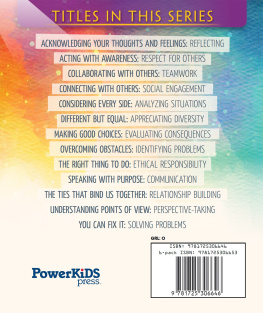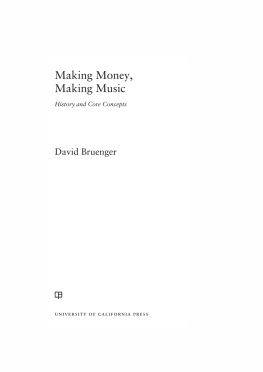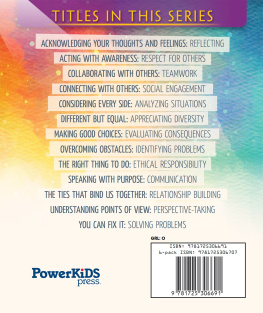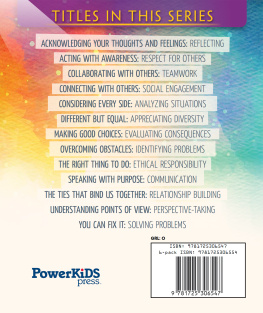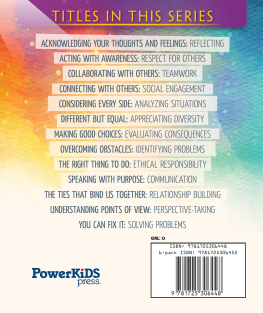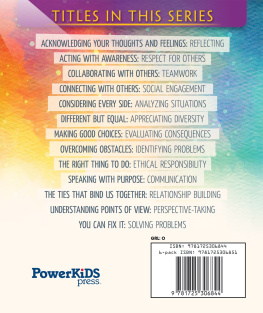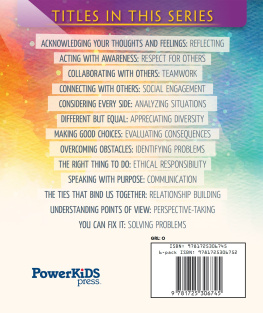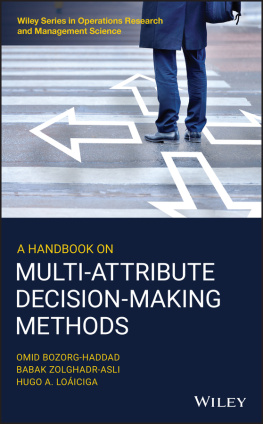
Published in 2020 by The Rosen Publishing Group, Inc.
29 East 21st Street, New York, NY 10010
Copyright 2020 by The Rosen Publishing Group, Inc.
All rights reserved. No part of this book may be reproduced in any form without permission in writing from the publisher, except by a reviewer.
Editor: Elizabeth Krajnik
Designer: Michael Flynn
Photo Credits: Cover Klaus Vedfelt/DigitalVision/Getty Images; cover, pp..
Library of Congress Cataloging-in-Publication Data
Names: Klimchuk, David, author.
Title: Considering every side: analyzing situations / David Klimchuk.
Description: New York: PowerKids Press, [2020] | Series: Spotlight on social and emotional learning | Series: Spotlight on social and emotional learning | Includes index.
Identifiers: LCCN 2019005180| ISBN 9781725306646 (pbk.) | ISBN 9781725306677 (library bound) | ISBN 9781725306653 (6 pack)
Subjects: LCSH: Judgment in children--Juvenile literature. | Decision making in children--Juvenile literature.
Classification: LCC BF723.J8 K585 2020 | DDC 155.4/1383--dc23
LC record available at https://lccn.loc.gov/2019005180
Manufactured in the United States of America
CPSIA Compliance Information: Batch #CWPK20. For further information contact Rosen Publishing, New York, New York at 1-800-237-9932.
Contents
CHAPTER ONE
STUDYING THE SITUATION
Every day, people run into different situations that challenge them in big and small ways. It can be easy for people to jump into these situations without thinking and to do something they . Thats why analyzing the situation first can be very useful. If people dont have all the facts, they might judge a person or idea unfairly. To analyze something means to study and examine it very carefully to see more clearly whats going on.
Analyzing situations also helps us learn what people, ideas, or suggestions they can trust and which ones need more . For example, if one of your friends tells you that cheating on a test could help you get a better grade, you might want to analyze how much you can trust that person and what the consequences could be.

Sometimes conflict or arguments can be avoided by taking time to analyze a situation before acting.
CHAPTER TWO
MAKING GOOD CHOICES
Analyzing situations is an important social and emotional learning skill that helps people make responsible decisions. Many times, people . They might even find that the situation isnt as bad as they thought and their feelings might change.


Analyzing situations can help people make good choices, such as choosing healthy foods over unhealthy foods.
Sometimes unexpected situations happen, and people have to adapt, or change, to handle them. By learning and practicing skills for analyzing situations, people may find they get along better with others and feel more .
CHAPTER THREE
WHATS THE PROBLEM
The ability to analyze situations is a very useful skill. For example, your friend may want you to come over after school, but you know you have homework to do. You may need to analyze the situation before making a decision too quickly.
Before you start analyzing, its helpful to stop and think about what exactly the problem is. This will help you make the best choice . In the example above, the problem is that you cant do homework and play at the same time. By the end of the day, your homework must be done, or you may get in trouble or get a bad grade. Your problem will be solved if you decide to do homework before playing with your friend. However, if you dont know what the problem is, you might act on your emotions and decide to play instead of doing your homework.


Moving too quickly when you have a decision to make can lead to mistakes.
CHAPTER FOUR
LOOKING INTO IT
The next step in analyzing a situation is to spend time looking into whats going on. This means asking questions so you have more and can make the best choices. By getting more information and noticing different parts of the situation, you can be better prepared to tackle whatevers in front of you.

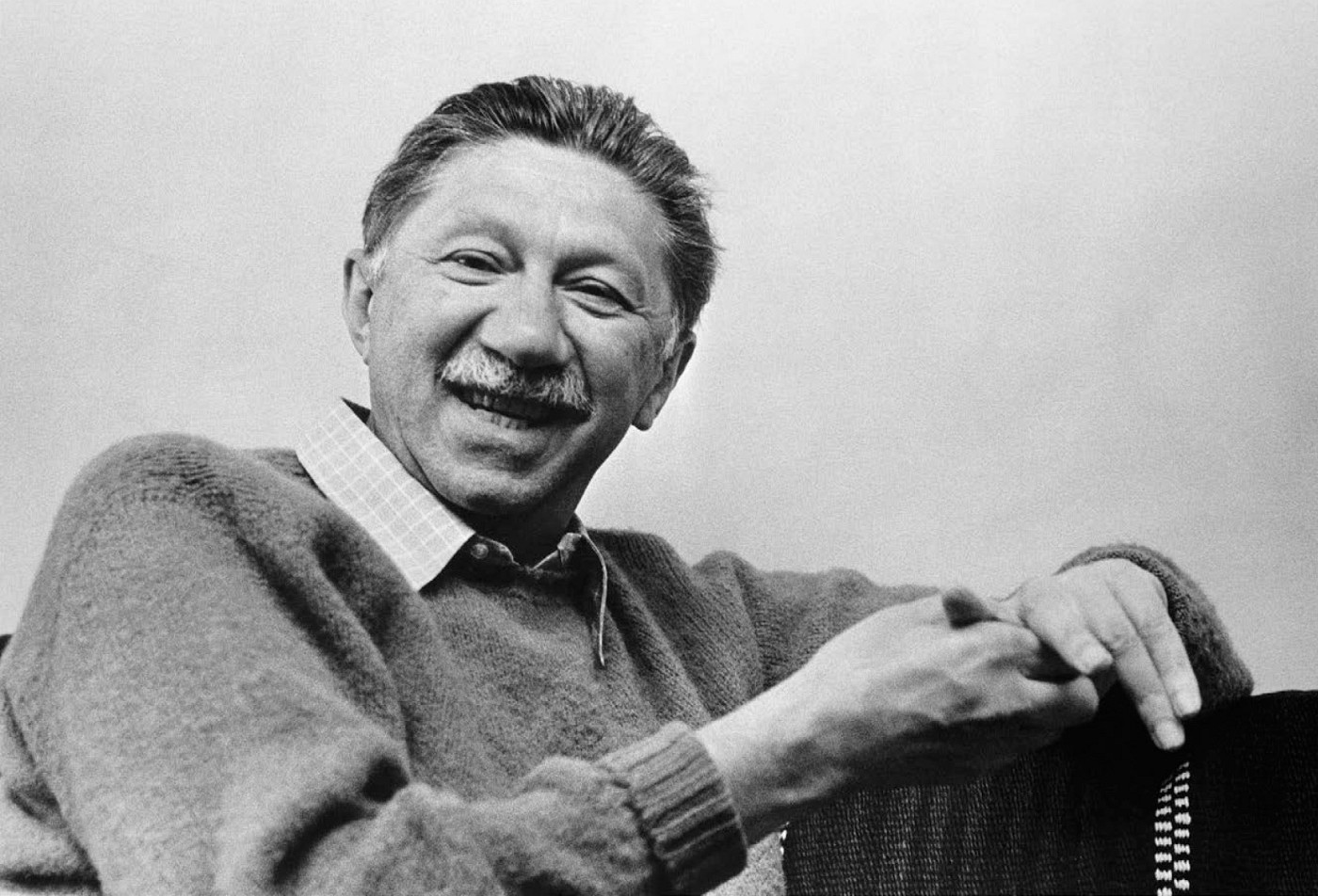
Abraham Maslow, an American of needs, which breaks down our needs based on whats most needed for us to survive.
One important question to ask is: What do I actually need? Sometimes people act on something they want, which doesnt always help them. Separating needs from wants can save people a lot of trouble. Another question is: How will this affect other people? When peoples emotions take over, they sometimes only think about how the outcome of a situation will affect them, not how it will affect anyone else. Before making any decisions, try asking some of these questions.
CHAPTER FIVE
DIFFERENT SIDES TO THE STORY
No two people are exactly the same. Everyone has their own experiences that make them special and one of a kind. When analyzing a situation, its important to remember that different people might have very different . For example, if your teacher asks your class to write down all the words that come to mind when they think of the word neighborhood, everyone would have different responses. This is because everyone has their own idea of what a neighborhood may look, smell, sound, or feel like. The same thing applies to how people see different situations.
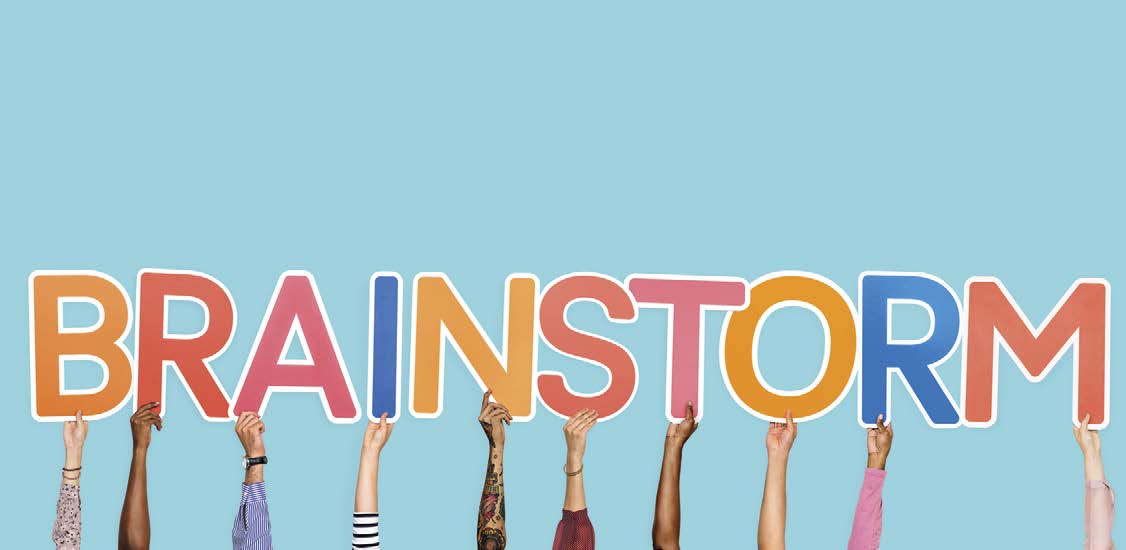
Alex F. Osborn, an American businessman and author, came up with the idea of brainstorming, which is when a group tries to solve a problem by coming up with a number of different ideas at the same time and writing them down.

One way to practice seeing different sides of the story is to ask yourself, How would I feel if I were the other person? This question can help you be more empathetic, or understanding of and able to share other peoples emotions and experiences.
CHAPTER SIX
WHAT CAN YOU CONTROL?
An important part of analyzing situations is knowing what can and what cant be controlled. One way to work through unpleasant situations is to learn how to balance what can be changed and what needs to be accepted. Sometimes there are parts of a situation that people cant change.
For example, you cant make your teacher stop giving your class homework just because you dont want to do it. When analyzing this situation, you may realize that you cant control your teachers choices. The teacher is in charge and needs to be respected. However, something you can control is how you respond to the situation. If youre having a hard time understanding the homework, you can ask the teacher, your parents, or a classmate for help. Knowing what can be changed and what needs to be accepted can help people make more responsible decisions.
Next page
